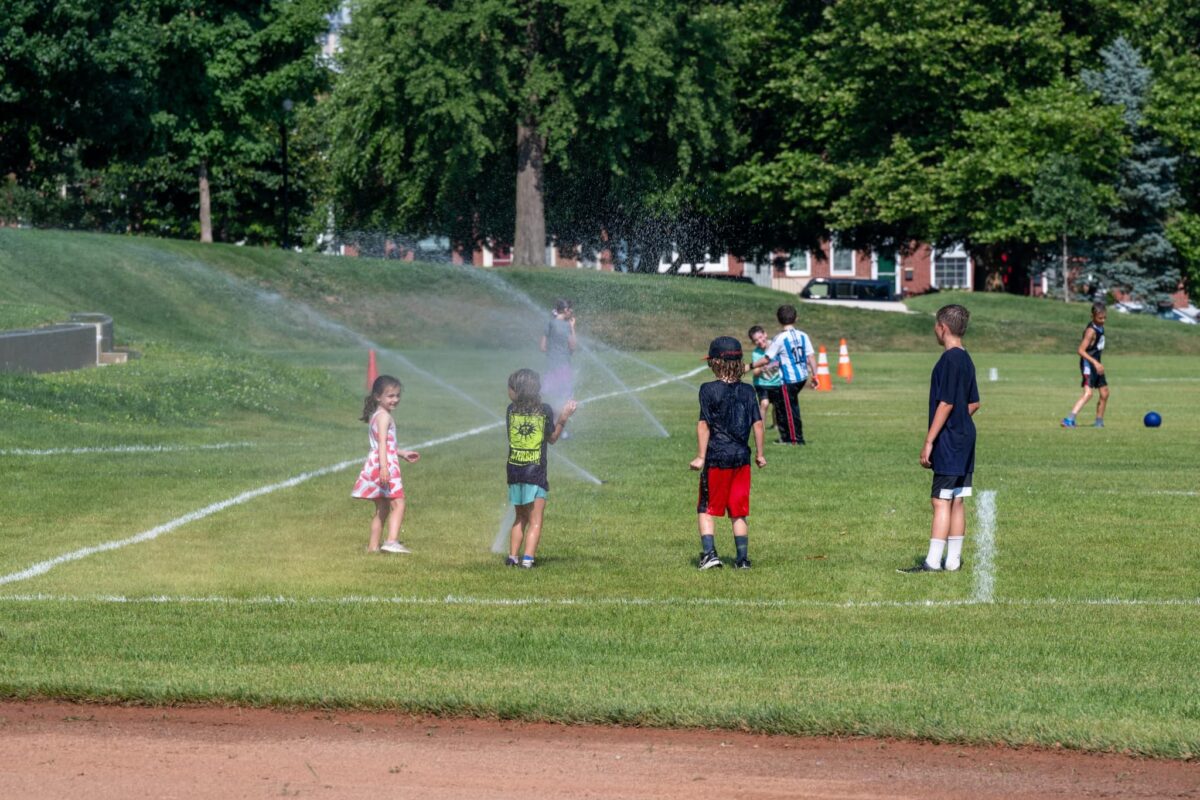
Sunny and 90 degrees might seem sweltering to some, but for Baltimoreans, it’s a welcome respite after experiencing more than 100-degree days in our recent end-of-June heat wave—which broke multiple historic records.
The 100-degree Saturday was the hottest June 22 ever recorded, and it was the first time the temperature reached 100 degrees in June since 2012, according to the National Weather Service. The day before, the heat climbed to 98 degrees, beating the last record of 97 degrees set in 2010 and 1894.
While high temperatures and humidity aren’t uncommon in Baltimore—especially in July and August—this is an unusual heat wave, says Benjamin Zaitchik, a professor at Johns Hopkins University who studies climate variability.
“This is hot in general for Baltimore, but especially this early in the year,” says Zaitchik. “Summer only officially started a couple of days ago.”
This June in Baltimore is projected to rank third out of the last 50 Junes for the most days reaching 90 degrees or higher, according to data from the National Weather Service. This year’s total of 14 days was only beat by 2010, which saw 16, and 1994, which had 15.
Baltimore City Health Commissioner Ihuoma Emenuga declared a Code Red Extreme Heat Alert on Thursday, opening free cooling centers scattered throughout the city. The same day, Gov. Wes Moore issued a State of Preparedness declaration for the weekend, which coordinates state preparations ahead of hazards or threats.
The AFRAM festival at Druid Hill Park, which drew crowds of more than 200,000 last year, continued despite the scorching temperatures (with safety precautions in place), while other outdoor events, such as those affiliated with the Special Olympics Maryland Summer Games, were cancelled.
“The challenge for climate change is defining what is normal,” says Paul Ferraro, a professor at Johns Hopkins University who studies the applications of environmental programs. “The issue is that it seems like the frequency of these earlier and more intense heat waves is increasing.”
Baltimore isn’t alone. Much of the country has been smothered by record-breaking temperatures because of a heat dome—a high-pressure atmospheric system that causes warm air to be pushed to the surface and stay there—that started in the Midwest before shifting east last week, according to the National Oceanic and Atmospheric Administration.
The heat is expected to move south to the Southern Plains this week, but Baltimore temperatures are still forecasted to be in the 90s.
How to stay safe
Experts advise applying generous amounts of sunblock, wearing light and protective clothing, and minimizing sun exposure. Drink plenty of water and stay away from caffeine or alcohol—which add extra strain to your body—to stay hydrated and combat heat-related illnesses.
It also might be best to reconsider that outdoor run or bike ride. Your body’s internal temperature can start rising just 15 minutes after starting a hot workout, and normal methods of dissipating heat during strenuous activity—such as sweating—are harder when there’s more humidity in the air and a lower evaporation rate.
Cooling down in air conditioned areas lets your body recover from being outside in hot temperatures. Public libraries, some senior centers, and cooling centers operated by the city’s health department are open to the public during code red heat alerts. Museums and malls are also dependable, air-conditioned places to spend prolonged amounts of time to escape the heat.
And while it’s not the fastest or most health-efficient way to cool off, grabbing ice cream or a snowball at one of the city’s many roadside shops can provide temporary relief.
Pet safety
The Humane Society of the United States warns against leaving pets in the car, even while the air conditioning is on. Temperatures inside a vehicle can rapidly rise to dangerous levels, especially on an 80 or 90-degree day.
Limit walking your pets to the morning or evenings when temperatures are the coolest. A good rule of thumb: If you can’t hold your hand on the pavement for at least 10 seconds, the surface is too hot for your pets’ paws.
It’s also important to pay special attention to short-nosed pets, such as pugs and French bulldogs, which typically have a harder time breathing, says Sunoh Che, an assistant professor at the University of Maryland and veterinarian.
“Animals are like humans, so they get stressed when they experience a heat wave,” says Che. “We have to really care for those species of animals. Their shortened airways make it harder to move air efficiently.”
Recognize signs of heat-related illness
Extreme heat is the deadliest natural hazard in the country, according to the National Weather Service. Data from the CDC shows the rate of heat-related emergency department visits spiked on Sunday in the Mid-Atlantic region at a rate of 1,629 per 100,000 emergency department visits—the highest out of any region in the country.
Heat-related illnesses—heat cramps, exhaustion, and stroke—are caused by prolonged exposure to the heat without adequate fluids or relief, according to Johns Hopkins University.
Signs of heat exhaustion include heavy sweating, weakness, dizziness, nausea, and headache. Heat stroke is more severe, with symptoms such as high body temperature, confusion, and unconsciousness, while heat cramps involve muscle spasms.
“People need to take the heat seriously,” says Zaitchik.
Know how the heat affects different parts of Baltimore
Parts of Baltimore experience more intense heat than others because of the urban heat island effect, which causes city temperatures to rise higher than surrounding rural or suburban areas. Lack of vegetation and heat-absorbing infrastructure such as buildings, roads, and concrete lead to greater retention of heat in the surrounding area, according to Zaitchik.
“We’ve all walked down these streets in Baltimore where it’s just concrete,” says Zaitchik. “That might make the temperature a little bit higher, but more importantly, it makes the heat you feel higher.”
A Climate Central analysis finds that about 45 percent of Baltimoreans live in an areas with an urban heat island index (UHI) of eight degrees or higher, a measure reflecting the increase in temperature from the effect. The Canton area has the highest UHI at more than 12 degrees.
Something residents may not consider is how dangerous nighttime heat can be, says Zaitchik. Heat from the day gets absorbed into the concrete, asphalt, or buildings and stays there. At night, the retained heat is released back into the air.
Nighttime heat worsens in spaces lacking air conditioning, which is one way the urban heat island effect exacerbates existing systems of inequality, says Ferraro of JHU.
“Heat island effects tend to be more extreme in minoritized communities,” says Ferraro. “They have less tree cover, more impervious surface, they’ve got fewer parks, and they have homes that are poorly insulated, so that even when they do use cooling, it’s hard to retain.”
Explore this map to see the UHI in your area. If you’re in a high-index spot, consider increasing shade around where you live by planting trees or installing a green roof, and make sure to check in on your neighbors. Young children, older adults, pregnant people, and individuals with medical conditions that make them more susceptible to heat-related illness are most vulnerable in the high temperatures, according to the U.S. Department of Health and Human Services.
“Keeping yourself safe means being smart about it, no matter what your underlying perceived vulnerability is,” Zaitchik says. “But also keeping others safe. Checking in and being thoughtful about how you plan events is going to be important.”
